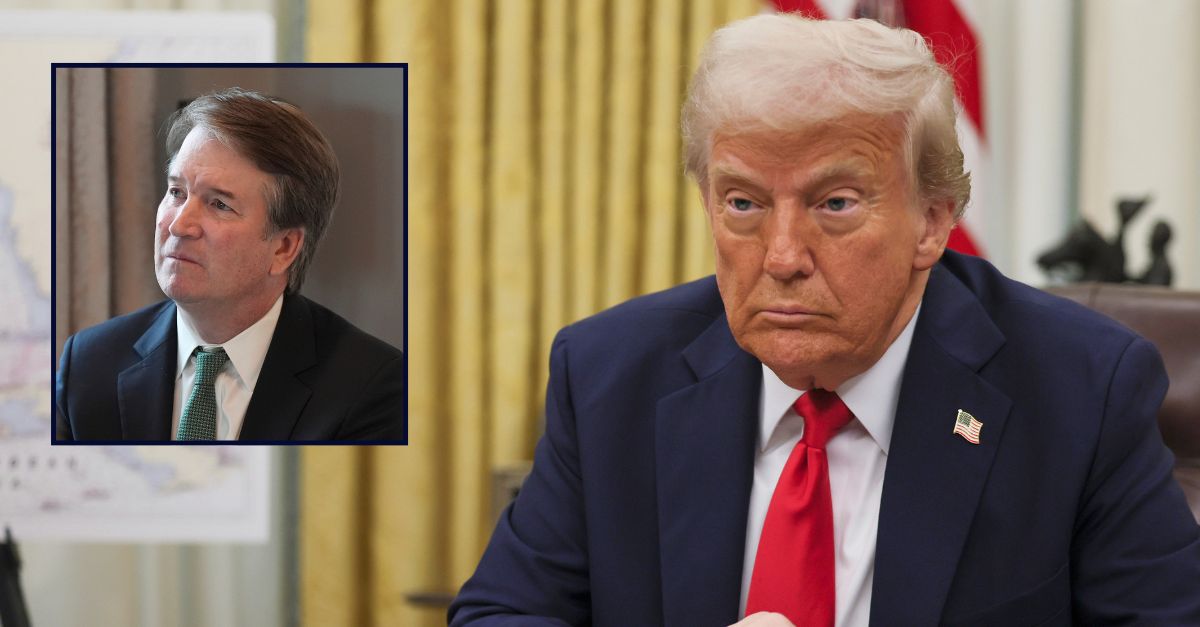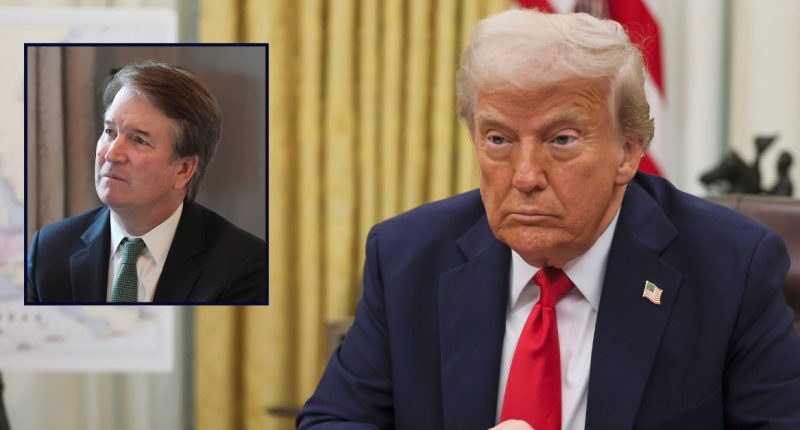Share this @internewscast.com

Inset: Brett Kavanaugh, Associate Justice of the U.S. Supreme Court, observes as Irish Prime Minister Micheal Martin delivers a speech during a breakfast event organized by U.S. Vice President JD Vance at his official residence in Washington, D.C. This event is part of Martin’s week-long trip to the U.S. on March 12, 2025. (Press Association via AP Images). Background: President Donald Trump pays attention to a reporter’s question before he signs an executive order in the White House’s Oval Office, Washington, on Monday, March 31, 2025 (Pool via AP).
A lawsuit filed on Monday in a federal court in Washington, D.C., accuses President Donald Trump of attempting to unilaterally set national election regulations, which the suit claims is against both federal law and the U.S. Constitution.
On March 25, President Trump, serving as both the 45th and 47th president, released Executive Order 14248, named: “Preserving and Protecting the Integrity of American Elections.” This directive aims to significantly reform how elections are conducted nationally. Among its provisions are requiring all voters to present official documentation to prove citizenship and discontinuing the practice of counting mail-in ballots that are postmarked by, but not received by, Election Day.
The plaintiffs, led by the Democratic National Committee, claim in their 74-page lawsuit that the executive order “asserts unprecedented authority” for the presidency over election administration “on a host of topics.” And this effort, the lawsuit claims, contravenes a number of federal laws and the explicit constitutional carveouts for election authority granted to the states and U.S. Congress.
“In the United States of America, the President does not get to dictate the rules of our elections,” the complaint begins. “The Framers of our federal Constitution foresaw that self-interested and self-aggrandizing leaders might seek to corrupt our democratic system of government to expand and preserve their own power. They therefore created a decentralized system of elections based upon separated powers divided among the leaders elected by — and closest to — the people.”
The lawsuit seeks myriad injunctions against various parts of the executive order. The lawsuit also asks a judge to declare several sections of the executive order “ultra vires and legally void,” that other sections “violate the constitutional separation of powers and are not enforceable,” and that one section “violates the vertical separation of powers” and the 10th Amendment — one of the least used, and least successful, constitutional challenges.
The 10th Amendment, an unlikely vehicle for worthwhile litigation, gives “to the States” all “powers not delegated to the United States by the Constitution, nor prohibited by it to the States.”
But the representative institutions of the Democratic Party apparently believes they have a rare winner here because of how far-reaching the order might intrude into electoral prerogatives long-exercised by the states.
Chief among the issues implicated by the executive order are laws in “nearly thirty” states that allow voters to cast valid ballots by Election Day “if received by election officials within a prescribed time.” President Donald Trump, for his part, likens such laws to “allowing persons who arrive 3 days after Election Day, perhaps after a winner has been declared, to vote in person at a former voting precinct.”
The federal court system has, almost uniformly, vindicated many vote-by-mail systems as constitutionally and statutorily sound. But there is one — and only one — glaring group of judges who have gone against the grain: the U.S. Court of Appeals for the 5th Circuit.
In October 2024, a panel of Trump-appointed judges ruled that a Mississippi state law allowing ballots to be received and counted after Election Day is in violation of federal law. In their opinion, the judges found the true mark of an election is a deadline for receiving ballots. And, the court explained, the federal deadline for selecting presidential electors and members of Congress has been fixed in law as “the Tuesday after the first Monday in November” since 1845.
The lawsuit takes stock of several other lawsuits filed by Republican Party plaintiffs in recent years attempting to overturn such laws. Each time, except for the Mississippi challenge, such lawsuits failed.
And here, the Democrats cry foul over the effort to extrapolate the 5th Circuit’s reasoning onto the country writ large. Indeed, Trump’s order explicitly relies on that case — Republican National Committee v. Wetzel — to rail against, and justify a move away from, how “many American elections now feature mass voting by mail, with many officials accepting ballots … received well after Election Day.”
“Despite this lopsided precedent, President Trump’s Order seeks to elevate one court’s anomalous and incorrect decision in order to strike down laws in States that have exercised their sovereign and constitutional prerogative to help their residents vote, particularly those who live or serve overseas or who rely on mail voting to access the ballot box,” the lawsuit reads.
In service of protecting such vote-by-mail laws, the Democrats pit the conservative 5th Circuit against Trump-appointed U.S. Supreme Court Justice Brett Kavanaugh.
The original petition also takes great umbrage at Trump’s efforts to effectively condition voting on “documentary proof of citizenship.”
The executive order outlines “only a narrow set of documents” for purposes of proving citizenship, the lawsuit explains. And these are “documents that millions of Americans do not possess,” according to the lawsuit.
In the executive order, such documents are limited to a U.S. Passport, a REAL ID, a military identification card, or “a valid Federal or State government-issued photo identification if such identification indicates that the applicant is a United States citizen or if such identification is otherwise accompanied by proof of United States citizenship.”
The lawsuit suggests millions of Americans will be locked out of their voting rights under such a stringent set of rules.
“At least 21.3 million — nearly 9 percent of American citizens of voting age — lack access to documentation necessary to prove citizenship,” the lawsuit says. “When Kansas briefly implemented a similar DPOC requirement, approximately 12 percent of all registrants — tens of thousands of voters — had their applications rejected, even though it was undisputed that nearly all of them were U.S. citizens.”
The combination of the directives in the executive order, the plaintiffs say, “will come down hardest on” the Democratic Party and its voters. And, the lawsuit says, that is actually “by purposeful design.” The ballot deadline section of the executive order is singled out here as the plaintiffs plead for a quick injunction.
“[T]he voters whose ballots are rejected due to receipt past the deadline are disproportionately those from groups of citizens who tend to be registered Democrats,” the lawsuit goes on. “And if there was any doubt as to the intended effect of the Order, President Trump has frequently and vocally attacked voting by mail and his belief that it helps Democratic candidates win elections.”
Love true crime? Sign up for our newsletter, The Law&Crime Docket, to get the latest real-life crime stories delivered right to your inbox.
In the end, the plaintiffs say, Trump’s efforts to remake the electoral system according to his own wants is both burdensome and completely lacking in any kind of authority.
“The Order requires that the President’s own design preferences be implemented on congressionally mandated voter registration forms, notwithstanding Congress’s clear contrary commands, imposing unjustifiable burdens on all Americans — and especially servicemembers and their families, women, and lower-income voters — attempting to register to vote in federal elections,” the lawsuit argues. “Although the Order extensively reflects the President’s personal grievances, conspiratorial beliefs, and election denialism, nowhere does it (nor could it) identify any legal authority he possesses to impose such sweeping changes upon how Americans vote. The reason why is clear: the President possesses no such authority.”

















